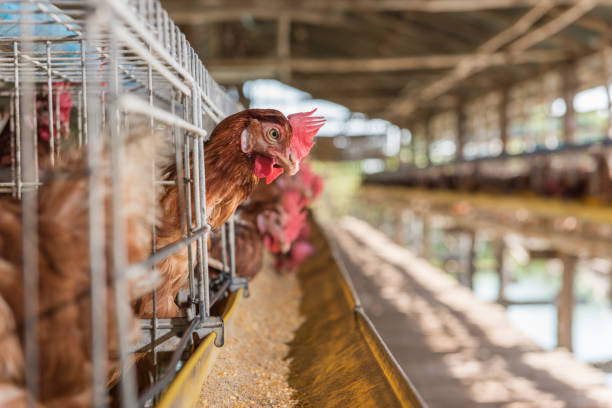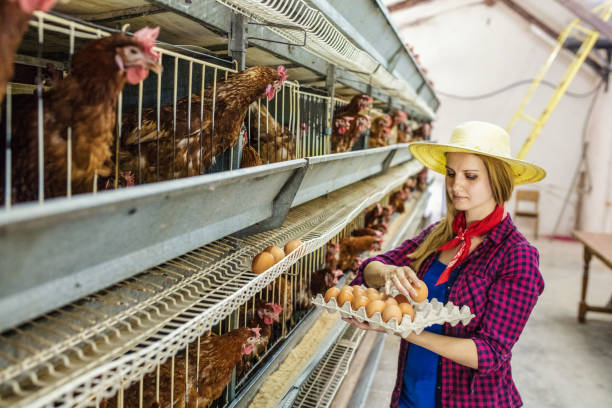Investing in Broiler Cage Systems: Scalable Solutions for 50,000 Chicken Farms in Africa
Investing in Broiler Cage Systems: Scalable Solutions for 50,000 Chicken Farms in Africa
The African poultry industry is poised for significant growth, and at the heart of this expansion lies the efficient, scalable, and cost-effective raising of broiler chickens. For farm owners looking to scale up to a 50,000-chicken operation, broiler cage systems are not just a consideration, they are a necessity. This article delves into the advantages of broiler cage systems, the key factors to consider when choosing a system, and how these systems can be a profitable and sustainable solution for African poultry farmers.
Africa’s Burgeoning Poultry Market and the Need for Efficiency
Africa’s population is booming, and with it, the demand for protein, particularly chicken. Traditional free-range methods, practiced for generations, can struggle to meet this increasing demand. They are often labor-intensive, less efficient in terms of land use, and expose chickens to a higher risk of disease and predators. Broiler cage systems offer a modern, controlled environment that tackles these challenges head-on.
What are Broiler Cage Systems?
Broiler cage systems involve raising broiler chickens in specifically designed cages, usually made of galvanized steel wire mesh. These cages are arranged in tiers, maximizing space utilization within the poultry house. Each cage houses a specific number of chickens, allowing for easy monitoring and management.
Benefits of Broiler Cage Systems for Large-Scale Farms.
For a 50,000-chicken farm, the benefits of broiler cage systems are magnified:
Increased Stocking Density: Cage systems allow you to house more chickens in the same amount of space compared to floor rearing. This translates into higher production output per square meter, maximizing your investment. Think of it as building up, not out.
Improved Feed Conversion Ratio (FCR): With less movement and greater control over the environment, chickens in cages expend less energy. This leads to better feed conversion, meaning they gain more weight with less feed. Over 50,000 chickens, even a small improvement in FCR can save significant amounts of money.

Reduced Disease and Mortality: Elevated cages minimize contact with litter and feces, reducing the risk of coccidiosis and other diseases. The controlled environment also makes it easier to maintain optimal temperature and ventilation, further enhancing chicken health. Less illness equals less loss and more profit.
Easier Management and Monitoring: Cages allow for easier observation of individual birds, enabling early identification of sick or injured chickens. Simplified feeding and watering systems reduce labor costs and ensure consistent access to resources. Spotting a problem early can make all the difference.
Better Meat Quality: Chickens raised in cages tend to have cleaner, more uniform meat quality. The controlled environment minimizes bruising and ensures even growth. This can lead to higher market prices for your product.
Manure Management: Broiler cage systems facilitate easier manure collection and management. Manure can be collected regularly and processed into fertilizer, creating an additional revenue stream or reducing fertilizer costs for other farming activities. Turning waste into wealth is always a smart move.
Choosing the Right Broiler Cage System: Key Considerations
Investing in a broiler cage system is a significant decision. Here’s what to consider:
Cage Design and Size: The cage design should prioritize chicken welfare, providing adequate space for movement and preventing overcrowding. Ensure the cage size and height are suitable for the breed of broiler you are raising. A happy chicken is a productive chicken so choose wisely.
Material Quality and Durability: Opt for cages made from high-quality, galvanized steel to withstand the corrosive environment of a poultry house. The cage material should be easy to clean and disinfect. You want cages that will last for years, not months.
Ventilation and Temperature Control: Proper ventilation is crucial for removing ammonia and maintaining optimal temperature. The cage system should be designed to facilitate good airflow. Consider integrating fans, cooling pads, or heating systems depending on the local climate. A comfortable house is a healthy house, and a healthy house is a wealthy house.
Feeding and Watering Systems: Choose automated feeding and watering systems that deliver consistent and adequate feed and water to each cage. Nipple drinkers are a common choice as they minimize water wastage and reduce the risk of contamination. Automation saves time and reduces the risk of human error.
Manure Removal System: Select a manure removal system that is efficient and hygienic. Options include manual scraping, automatic scrapers, or belt systems. The system should be designed to minimize odor and prevent the build-up of harmful gases. Nobody wants to work in a smelly, unhygienic environment, and neither do your chickens.
Automation and Technology: Consider incorporating automation technologies such as automated climate control, lighting systems, and data monitoring. These technologies can improve efficiency, reduce labor costs, and provide valuable insights into flock performance. Technology can take your farm to the next level.
Supplier Reputation and Support: Choose a reputable supplier with a track record of providing high-quality broiler cage systems and excellent customer support. Look for suppliers who offer installation services, training, and ongoing maintenance support. A good supplier is a partner in your success.
Scalability: Ensure the chosen system is scalable. As your business grows, you should be able to easily add more cages to increase capacity. It is better to be prepared for growth rather than be limited later on.
Cost Analysis: A 50,000-Chicken Farm
Setting up a broiler cage system for 50,000 chickens involves significant upfront investment. Here’s a breakdown of estimated costs:
Cage System: This is the major cost, ranging from $50,000 to $200,000 depending on the level of automation, materials used, and supplier.
Poultry House: Building or renovating an existing structure to house the cages can cost $30,000 to $100,000.
Equipment: This includes feeders, drinkers, ventilation systems, lighting, and manure removal systems, totaling around $10,000 to $30,000.
Chicks: Purchasing 50,000 broiler chicks can cost $25,000 to $50,000, depending on the breed and source. This is assuming a cost of, say, $0.50-$1 per chick.
Feed: Broiler feed is a recurring cost. You can expect to spend $100,000 to $200,000 on feed for a typical 6-8 week grow-out period for 50,000 chickens. It is important to shop around to get the best deal on feed.
Labor: Labor costs will vary depending on the level of automation. Expect to spend $5,000 to $15,000 per grow-out period on labor.
Other Costs: Include expenses for electricity, water, medication, and waste disposal. Budget $5,000 to $10,000 for these miscellaneous costs.
Financial Projections and ROI.
To determine the profitability of a broiler cage system, consider the following:
Production Cycle: Broilers typically reach market weight in 6-8 weeks.
Mortality Rate: A well-managed cage system should have a mortality rate of less than 5%.
Market Price: The price of broiler meat varies depending on the location and market conditions. Do your research to determine the average price per kilogram in your area.
By calculating the total cost of production and the revenue generated from selling the broilers, you can estimate the return on investment (ROI). Remember to factor in the costs of financing and depreciation of equipment. You want to make sure the numbers add up before you invest.
Sustainability and Environmental Considerations
While broiler cage systems offer significant efficiency gains, it’s important to consider the environmental impact:
Manure Management: Implement proper manure management practices to minimize odor and prevent pollution. Composting, anaerobic digestion, and using manure as fertilizer are sustainable options.
Energy Efficiency: Use energy-efficient lighting and ventilation systems to reduce your carbon footprint. Consider using solar power or other renewable energy sources.
Water Conservation: Implement water-saving technologies such as nipple drinkers to reduce water wastage.

Biosecurity: Good biosecurity practices are essential for preventing the spread of disease. Implement strict hygiene protocols and limit access to the poultry house.
Success Stories in Africa – Learn from Others

Across Africa, farmers are already experiencing the benefits of broiler cage systems. By visiting successful farms, attending poultry conferences, and networking with other farmers, you can learn best practices and avoid common pitfalls.
Livi Machinery and Broiler Cage Solutions
Livi Machinery stands as a leading supplier of high-quality broiler cage systems tailored for the African market. We understand the specific challenges and opportunities faced by African poultry farmers and offer solutions designed for durability, efficiency, and profitability.
Our systems are manufactured using premium-grade galvanized steel, ensuring longevity and resistance to corrosion. We offer a range of cage designs to suit different breeds and farm sizes, with options for automated feeding, watering, and manure removal.
Our team of experienced engineers and technicians provides comprehensive installation, training, and after-sales support to ensure your success. We are committed to helping you maximize your investment and achieve sustainable growth in the poultry industry.
Conclusion: The Future of Broiler Farming in Africa
Broiler cage systems are not just a trend, they are a sustainable solution for meeting the growing demand for chicken in Africa. By investing in the right system and implementing best management practices, you can create a profitable and environmentally responsible poultry farm. The opportunity is ripe. The demand is high. It is time to take your poultry business to the next level.





